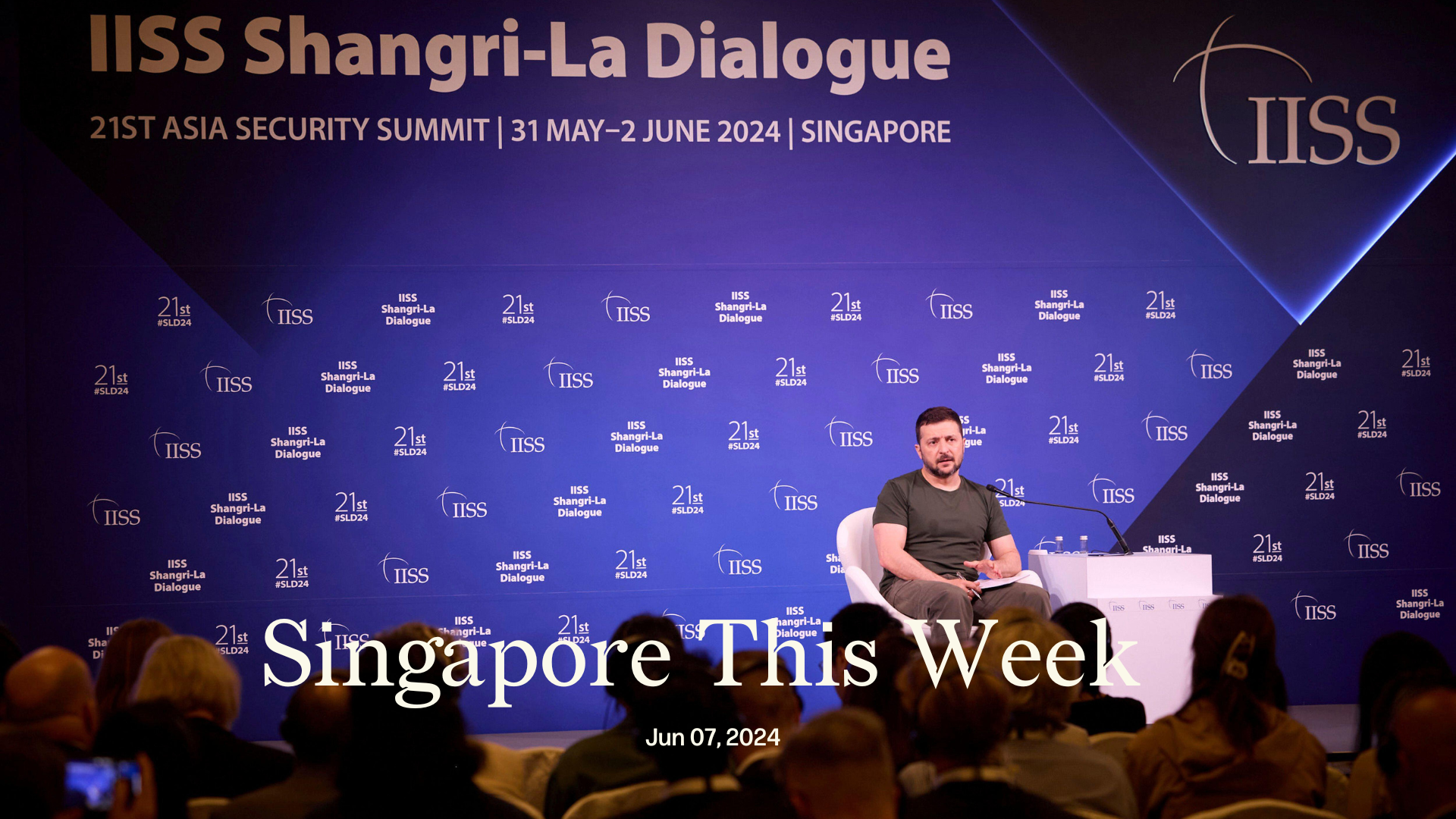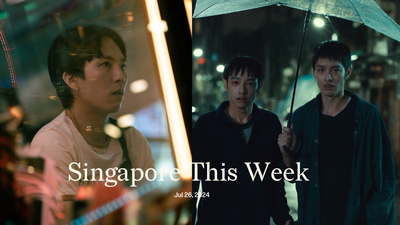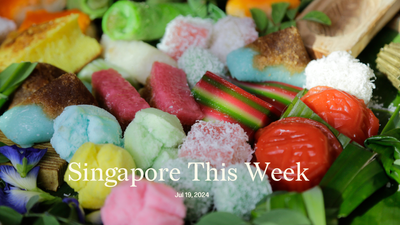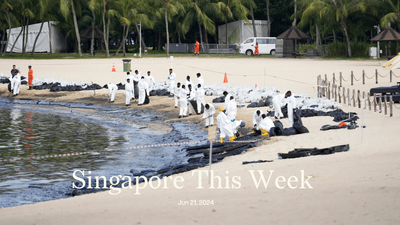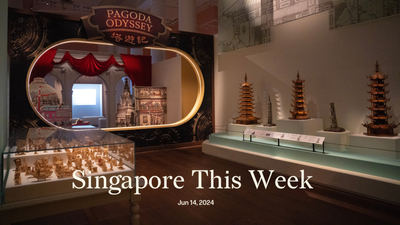Politics: Volodymyr, and Xi who shall not be named
This year’s Shangri-La Dialogue was unique because Volodymyr Zelensky, Ukrainian president, made a surprise visit and scolded China for its apparent pro-Russia meddling. Participants at the annual security pow-wow, organised by the London-based International Institute for Strategic Studies, usually offer tame and oblique criticisms of Beijing, more shadow boxing than truth-telling. This year, both the US and the Philippines traded blows with China over Taiwan and the South-China Sea, respectively, without naming it.
Zelensky dispensed with tact. “Russia, using Chinese influence in the region, using Chinese diplomats also, does everything to disrupt the [upcoming] peace summit,” Zelensky said. The Swiss have invited some 160 countries to the event on June 15th-16th, but not Russia, which anyway said there’s no point to the conference. China has said it won’t attend. But more than that, alleged Zelensky, it’s been doing Moscow’s dirty work. “Regrettably this is unfortunate that such a big independent powerful country as China is an instrument in the hands of [Vladimir] Putin.” (China later denied this.)
More broadly, it was again interesting to witness the contradictions and hypocrisy of global diplomacy. Ng Eng Hen, Singapore’s defence minister, said that Zelensky’s appearance was “the epitome of what we are all hoping for, a rules-based order that guarantees the security and survival of large nations and small.” And yet, as the 2003 Iraq war showed, Singapore will happily ignore the rules-based order to support a larger power against a smaller one when it’s expedient. Among other testosterone-charged speed dates, Zelensky met Prabowo Subianto, Indonesia’s next president, and a former general suspected of committing atrocities against the East Timorese and others before he was dismissed from the army.
As the quick rehabilitation of Mohammed bin Salman, Saudi leader, across liberal democracies has shown, memories are short, and we can’t always choose our friends. In a commentary on the Dialogue, Alan Chong of the S. Rajaratnam School of International Studies said the supposed “candid multilateralism” will have succeeded if it slows down or ends the war. Zelensky at least appeared happy on his trip to the Istana, where he signed an air deal, and also met Tharman Shanmugaratnam, president, and corporate big-wigs from Temasek, GIC, and Wilmar International, one of the world’s biggest oil palm plantation owners. Once the Russians leave, Singapore Inc may rush in.
Society: The Crusades against speech and thought
Conservative politicians in Singapore, obsessed since independence with Western liberal demons, have in recent years railed against an imaginary intolerant left. In his swansong interview as prime minister, Lee Hsien Loong took aim at “wokeness”. K Shanmugam, the home affairs and law minister, may want to legislate against “cancel culture”. Yet for those of us who actually get stuck in the weeds of public discourse here, it’s clear that the most insidious American influence is not from the coastal, secular far left, but the insular, religious far right.
Around 12pm last Sunday, Science Centre Singapore publicised an event titled “What’s the difference between sex & gender?” Open only to adults, it featured three speakers: Mie Hiramoto, an associate professor and the principal investigator for the gender and sexuality research cluster at the National University of Singapore; Alexander Teh, a youth counsellor at Oogachaga, a non-profit working with LGBTQ+ individuals; and Becca D’Bus, a drag queen. Around 3pm, ProtectSingapore, an amorphous, self-professed NGO that “aims to protect the values of marriage, family, children and conscience”, rallied its 2,000-odd crusaders on its Telegram group, with a mix of fear mongering about harm to children, and desperate calls-to-action—urging members to e-mail Chan Chun Sing, the minister of education, among others. Four hours later, Science Centre Singapore capitulated to the mob. Offering neither apology nor explanation, it simply said that it “would like to take the opportunity to review our approach to this session”, and would offer refunds to those registered. ProtectSingapore celebrated, telling its troops that their “prompt and clear voices have made an immediate difference.” (Science Centre Singapore did not return a request for comment.)
Becca described the Telegram message as “like something out of the playbook of far-right, extremist, hate groups” in the US. She told Jom that critics perceived the gender event as a coordinated panel, but in reality the speakers were there to present views from their respective areas of expertise. (Becca’s presentation: “RuPaul has made things confusing”.) People should be free to express themselves without fear of being attacked, Shanmugam had said in 2022, when criticising cancel culture. What might he make of ProtectSingapore’s shutting down of discourse on an urgent issue? The messaging is that the government doesn’t even want adults discussing modern gender ideology. And is ProtectSingapore, cloaked in anonymity, even run by Singaporeans, or is it a tool, say, of the American far right? (ProtectSingapore did not return a request for comment.) One of the toughest challenges facing Lawrence Wong, Singapore’s first Christian prime minister, is the need to keep religion out of our secular public space. Becca, like disillusioned queer Singaporeans have so often done, found solace in humour. “I kind of love how I’ve been framed as a science educator. It’s fabulous.”
Society: Data for me, not for thee?
Should data collected from citizens be made freely available to all? This was the basis for a spirited conversation during a panel discussion, “Geospatial & Geography: Empowering Communities, Enhancing Lives”, at the World Cities Summit last week. Lily Kong, president of the Singapore Management University (SMU), spoke about the value of getting fresh perspectives from the public; Melbourne’s Lord Mayor Sally Capp considered it both desirable and obligatory. But panel moderator Ng Siau Yong, a director at the Singapore Land Authority (SLA), worried about advocacy groups abusing the data to “argue for benefits for a select few,” according to ST.
At the time of writing, a full transcript of the discussion was not available, so perhaps Ng’s question was more nuanced. Nonetheless, it’s a telling reminder of the state’s deep-seated distrust of civil society. This is especially galling in light of Wong’s Forward SG campaign, which repeatedly mentions making Singapore a more inclusive society. Surely that inclusivity extends to data sharing which can allow citizens, including—hold your noses—civil society, to put forth concerns and informed suggestions? As it is, the government’s data policies, both how much it amasses and how little it shares, are criticised by academics and activists alike. Instead of being skittish, institutions would do well to learn from countries like Taiwan where a vibrant digital democracy appears to be gaining ground.
Back at the summit, the panellists pushed back against Ng. Capp said freely available data creates common ground for discussions between government and citizenry; Rotterdam vice-mayor Vincent Karremans agreed. But the most incisive response came from SMU’s Kong who emphasised data’s role in encouraging participatory governance in mature societies. “That then makes for higher-quality debate in society that can then lead to better outcomes,” she said. And then the clincher: “But, of course, it does require readiness to engage openly and to acknowledge that actually, sometimes the perspective of interest groups might actually be valid.” Amen to that.
Society: Disbarred, but undeterred
First suspended, then sentenced to jail, now struck off the rolls. Ravi Madasamy, commonly known as M Ravi, will not be practising law for the foreseeable future after the Court of Three Judges, Singapore’s highest disciplinary body for lawyers, disbarred him for improper and dishonest conduct. In a 25-year legal career, Ravi faced a litany of disciplinary proceedings, ranging from assault to professional impropriety and false allegations against legal institutions. Most recently, The Law Society of Singapore had brought two cases against Ravi. The first was for making alleged “false and unwarranted attacks” on Facebook in August 2020 against Halimah Yacob, then president, as well as Lee Hsien Loong, then prime minister, and Goh Chok Tong, also a former prime minister. The second was for disruptive behaviour in court in November 2021 when representing former SBS Transit bus driver Chua Qwong Meng in a suit against the transport operator. Such acts, the court said, undermined the “administration of justice” and hence must be “met with stiff penalties”.
Ravi expressed remorse, a commitment to personal reflection and a resolve to overcome his mental health challenges. He was diagnosed with bipolar disorder in 2006, a condition which has been a mitigating factor in past cases against him, and also the reason he was deemed unfit to practise without supervision. This time, however, the disciplinary tribunal found that a supposed relapse of his mental health condition did not “exculpate him from liability”. In an interview with Free Malaysia Today in February, Ravi had spoken of his hope to see a more compassionate system of criminal justice in Singapore, where behavioural conditions weren’t only punished but supported in the long-term. In Canada and the US, for instance, mental health courts—often less formal than criminal courts—are designed to “deal with accused persons…experiencing mental health difficulties with understanding and sensitivity.”
Ravi’s legacy is complicated. His supporters laud the fact that he spent much of his career defending Singapore’s most vulnerable—including those on death row—despite the odds being stacked against him. His detractors deplore his tactics and behaviour, claiming he lowered the standards of his profession. Perhaps a fair assessment would consider him a troubled, compassionate, talented man who had the courage of his convictions.
History Weekly by Faris Joraimi
The Shangri-La Dialogue is meant to create an Asia-Pacific security framework modelled after similar annual defence summits in Europe. As great-power rivalries intensify, it’s also a barometer for US-China relations: the press scrutinises every snub, handshake or barb exchanged between senior government officials. The occasional drama, however, amid hours of tedious peace-building, initially feels removed from this event’s name. “Shangri-La” has a nicer ring than “Asia Security Conference” (its original title) and refers to the grand hotel of the same name on Orange Grove Road where it has always been held. But it was James Hilton’s 1933 novel Lost Horizon that created Shangri-La as a utopian idea.
As the story goes, a few Europeans fleeing revolution in British India accidentally find themselves in a lush Himalayan valley of eternal happiness and harmony. Here, everyone ages slowly, but it is ruled from a monastery with modern appliances, and whose High Lama (Tibetan spiritual master) is a European named Perrault. He wants Shangri-La to be a respite from the outside world, where “man, exalting in the technique of murder” is destroying civilisation. Says Perrault in the 1937 film adaptation, “Look at the world today. Is there anything more pitiful? What madness there is! What blindness! A scurrying mass of bewildered humanity crashing headlong against each other. The time must come, my friend, when brutality and the lust for power must perish by its own sword. For when that day comes, the world must begin to look for a new life. And it is our hope that they may find it here.”
That vision seems aligned with Singapore’s goal of being a stable refuge for cooperation in a tumultuous world. Shangri-La also blends fantasies of Oriental spirituality with Western leadership and technology, resembling our shallow rhetoric surrounding “Asian values” while being integrated with the US-led capitalist order. While the name means “Shang mountain pass” in Tibetan, its Chinese rendering contains the character for “fragrant”: similar to the China-organised Xiangshan (“fragrant mountain”) Forum in Beijing challenging the Shangri-La Dialogue’s prominence. Theories abound on Hilton’s inspirations for Shangri-La—from Pakistan’s Hunza valley to the Kunlun mountains—but like its namesake Dialogue, is an artificial construct of some Brits and Anglophiles. Will our longed-for peace be just as elusive? Meanwhile, the only evident location for Shangri-La—Tibet—remains under Chinese occupation.
Arts: ‘To see him rise again...it makes me happy’
1970. A 22-year-old biochemistry graduate from the University of Singapore makes an uncharacteristic leap—onto a Swiss ballet stage. The Dutch National Ballet spots his talent and he soars through the ranks of its corps de ballet, eventually becoming a soloist, then a choreographer. He sees patterns, lines and gestures where others do not, deftly combining fluencies in modern dance and classical ballet to sculpt both streamlined and surprising configurations of ensemble work. He’s spotted, again, this time by Mary Day of the newly-established Washington Ballet. The pioneering dancer-educator offers him a position as first-ever resident choreographer of the company, where he will remain for over a decade. His creations with the company will cement its place in the American ballet canon. He’ll also make work for superstars like Mikhail Baryshnikov. But this Singaporean comet will also die in his prime, at 39, from viral colitis—a complication from AIDS at the height of the epidemic’s moral panic in 1987.
Our most brilliant ballet émigré, the late Goh Choo San, had unvarnished words about the nation-state. “I hated Singapore. It was so stifling artistically. I couldn’t have done anything there. There’s no time for the arts, no subsidies, no time for anything but work and business. And to be a dancer...there’s little respect for a dancer in Singapore...In Singapore my life was a total facade. When I got to Europe I could dance, I could be myself,” Goh told New York-based Dance Magazine in 1980. If only he could see the trail he blazed for generations of Singaporean dancers by dancing and being himself, with his “speed, intricacies of movement, [and] difficult toe work”, in the words of the chief dance critic at The New York Times. This month, the Kennedy Center’s gala “10,000 Dreams: A Celebration of Asian Choreography” will feature a one-night-only tribute performance honouring Goh, with his beloved Washington Ballet performing “Fives” and the Singapore Ballet presenting “Momentum” as part of the lineup. Goh’s sister and fellow dancer Goh Soo Khim co-founded the Singapore Ballet (formerly Singapore Dance Theatre) in 1988, and his good friend Janek Schergen has been its artistic director (and custodian of his legacy) since 2008. Schergen told Tatler Asia: “The elephant in the room that nobody mentions is that one of the reasons Choo San has been relegated to a minor character in history is because his life was taken by the AIDS crisis...So to see him rise again...it makes me happy.”
Arts: Pink on the silver screen
Spend your dollars for a good cause at Pink Screen, The Projector’s annual LGBTQIA+ film festival. The indie cinema, together with NBCUniversal, has put together a lineup of queer films that both bend genres and break hearts—whether you fancy a drag-queen-neo-noir-revenge-thriller or a tearjerking-trans-dance-battle-K-drama. If you want to add lesbian-road-trip-inept-crime-caper to the list, there will be a special fundraiser screening of “Drive-Away Dolls” (2024). All proceeds from ticket sales will go to Oogachaga, celebrating its 25th birthday this year. The community-based non-profit has been working with LGBTQ+ individuals and groups in Singapore since 1999, and funds raised will support their professional counselling services and youth programmes. A Singaporean queer classic will also grace the silver screen. “Bugis Street” (1995) gets a rare re-release; it was banned in Singapore for two decades before its restoration and screening at the 2015 Singapore International Film Festival. The film follows hotel cleaner Lian from her mundane life in Malaysia to the glitter and glamour of 1960s working-class Bugis, then Singapore’s red light district (before the state sanitised it). “Bugis Street” celebrates a naive newcomer’s coming-of-age, as well as the warmth and tenderness extended to her by a close-knit community of trans sex workers.
This isn’t the only Pride Month fundraiser taking place: Centre 42 is marking its 10th anniversary with a “fun-raiser”. The theatre development space is restaging “Desert Blooms: The Dawn of Queer Singaporean Theatre”, a lecture-performance created by activist and playwright Ng Yi-Sheng that trawls through the annals of queer theatre history. For one day only, June 30th, audiences will get a whistle stop tour of a decade of queer performance on the Wild Rice stage in Funan Mall. As the centre puts it: “It showcases [our] key missions of resisting cultural amnesia, nurturing the next generation of theatre-makers and investing in local storytelling”. The film and theatre sectors have long been sanctuaries for Singapore’s queer community, particularly prior to the repeal of S377A, and now’s as good a time as any to pay it forward.
Tech: Safer AI for Singapore
Singapore’s AI Verify Foundation (AIVF) has introduced the AI Verify Project Moonshot toolkit, spearheading advancements in artificial intelligence (AI) safety and security. Developed in collaboration with industry giants like DataRobot, IBM, Singtel, and Temasek, this toolkit offers a comprehensive approach to managing risks in AI applications, particularly focusing on large language models (LLMs). By integrating red teaming, benchmarking, and baseline testing, Project Moonshot addresses the critical need for standardised safety assessments in AI development. AIVF’s partnership with MLCommons to establish a unified safety benchmark suite further emphasises the industry-wide commitment to enhancing AI application security. The launch of Project Moonshot coincided with the 2024 Asia Tech x Singapore conference, which welcomed leading AI entrepreneurs such as Anthropic CEO Dario Amodei and OpenAI CTO Mira Murati. With an expanding membership base and collaborations such as IBM’s partnership with AI Singapore to advance the SEA-LION LLM using Watsonx, Singapore continues to drive initiatives aimed at accelerating the responsible adoption of AI technologies in the region.
Tech: New Google data centre in Singapore
The completion of Google’s new data centre and expanded cloud region campus brings its total investment here to US$5bn (S$6.74bn), highlighting Singapore’s growing importance as a tech hub. With over 500 employees running Google’s Singapore data centres, the facilities are pivotal in supporting essential digital services like Google Search and Google Maps. The expansion of cloud services caters to clientele ranging from start-ups to public-sector organisations, reflecting the increasing demand for cloud-based solutions locally and internationally. In an effort to make its data centre operations more eco-friendly and sustainable, Google has adopted practices such as utilising recycled water for cooling systems and implementing water usage monitoring systems. It’s also invested in AI-powered initiatives, aligning with Singapore’s vision for digital transformation.
Tech: Taiwanese boost for Singapore’s semiconductor industry
Amidst the ongoing US-China chip war, Singapore’s strategic positioning as a neutral power enables it to attract major players in the semiconductor industry. The recent partnership between NXP Semiconductors and TSMC-backed Vanguard International Semiconductor Corporation to establish a US$7.8bn (S$10.5bn) chip wafer plant here reflects the region’s growing significance in semiconductor production. The collaboration aims to address diversification needs, with advanced 12-inch silicon wafers serving as the foundation for a range of semiconductor chips. Singapore’s position is built on decades of venturing into more advanced semiconductor manufacturing processes, leading to several major semiconductor companies having a strong presence in Singapore, such as GlobalFoundries, Micron Technology, and STMicroelectronics. Yet, Singapore has some catching up to do with its neighbour. McKinsey Global Institute data indicates that in 2022, nine percent of finished chips with a total value of approximately US$102bn (S$137.5bn) came from Malaysia, placing it fourth in the world. Singapore ranked fifth, with a six percent contribution and US$66bn (S$88.9bn) in total value.
To keep up, the Singapore government has announced strategic initiatives, such as the Electronics Industry Transformation Map and investments of S$180m to set up the National Semiconductor Translation and Innovation Centre, aimed at developing local talent and research and development capabilities.
If you enjoy Jom’s work, do get a paid subscription today to support independent journalism in Singapore.

